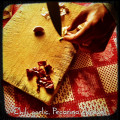A Dozen Useful Recipe Ingredients Beyond the Basics
The Pantry Staples are Basic
Anyone who likes to cook keeps staples and basic ingredients on hand.
As much as possible, I like to cook with fresh raw ingredients, but a few canned ingredients like diced tomatoes and green beans are often useful
Most pantries have pasta and rice, fresh potatoes and onions, flour, sugar and seasonings but there are a dozen or more items which might be a little "beyond the basics" that I hate to be without.
The "Beyond" LIST
1. Chicken Broth, or other broth.
Making your own is great but, the convenience of broth in a can or carton is wonderful. Broth with last night's leftover vegetables plus the leftover rice, pasta or potato can make a nice quick pot of soup for tomorrow's lunch.
2. Fresh Red Bell Pepper
Despite the intense color, a Red Bell is mild-tasting, even sweet. Chopped up or cut in slivers, it is a great addition to many recipes because it is high in nutrients and antioxidants. Another good thing about it is that it adds beautiful color and looks especially delicious with green vegetables or neutral color things like rice, pasta or mushrooms
Add a Surprise Flavor

3. Italian Seasoning
If you have fresh herbs, by all means, use them. When that is inconvenient, a blend of Italian herbs that includes Oregano, Basil, chives and perhaps a few other herbs goes well with many ingredients.
A few sprinkles of this blend adds a great boost of flavor to soups, sauces, marinades, homemade salad dressings and more. These are usually freeze-dried and come in a glass jar.
4. Extra Virgin Olive Oil and Grape Seed Oil
These are the two oils I like most, EV cold-pressed olive oil for dressings, and the grape seed oil for sauté or stir fry.
Grape seed oil is very light and has almost no taste of its own. It has a high smoking point, making it perfect for something you want to cook quickly in a hot pan without making threatening smoke signals or setting off the fire alarm. It is also very healthful and rates above olive oil in most of its nutritional components.
Grape seed oil used to be quite cheap compared to other oils, because it was a by product of the wine making industry, and also because people were unfamiliar with it. The seeds used to be tossed out after the winemakers were finished with the grapes -- then someone figured out how to extract oil from the seed. Now that its advantages are becoming better known, the price is rising a bit, but it still is less expensive than most cooking oils.
I save the more expensive extra virgin olive oil for fresh green salads or a drizzle over steamed vegetables. Personally, I think cooking with it is wasteful.
5. Blood Orange Vinegar
This is a specialty item, which might be hard to find. It is also a bit on the expensive side, but it makes a great salad dressing with a little olive oil. Its slightly sweet tang, perhaps mixed with a little honey, is also good on fruit salads.
Oil and vinegar dressing.
6. Asagio Cheese, Tillamook Extra Sharp Cheddar and Feta Cheese
These are my favorIte kinds of cheese to use in recipes. I used to use that dried up "parmesan"-- but a little shredded Asagio goes a long way and has tons of flavor compared to that saw-dust tasting stuff.
Sprinkle a little on steamed vegetables (especially summer squash), baked potatoes, garlic bread and other things.
Feta cheese can be used similarly, or crumbled onto salads.
For anything that wants to have cheese melted on it, I love Tillamook extra sharp cheddar (or another extra sharp cheddar) Again, I find the extra sharp has more flavor, so you can use a little less.
7. Corn-flakes.
You can eat them for breakfast, but I find crushed corn flakes are great for sautéing anything you want to bread with an egg wash and crumbs. Great for chicken, fish and anything else you want to bread and fry.
8. Dry Potato Flakes, Buds, Or Crumbles
Most good cooks wouldn't think of using this instead of real potatoes-- but in a pinch it is passable as a mashed potato-like substance. What I like it for most, is to thicken soups and gravies. It gives a nice thick, creamy texture without adding extra fat-- a great extender for soups and stews.
9. Baking Mix.
Though I 'd rather do most things from scratch, this mix that has been around for decades is just too convenient to not have on hand for biscuits, dumplings, pancakes, shortcake, and even quiche. It's versatility make it a staple.
10. Dry Vermouth
No, I don't make martini cocktails, but when cooking many chicken recipes that ask for white wine, I find the vermouth, with it's herbal overtones, adds an especially nice flavor to certain recipes. It can also make a nice aperitif when served Ice cold with hearty and seasoned appetizers. The cheap brands can taste really dreadful, so get a moderately pricey one and use it sparingly.
11. Worcestershire Sauce
The "real thing", not a knock off imitation worcestershire, adds a pleasant taste, and helps the meat brown nicely. Again, the cheaper ones just don't seem to do right for your steaks, roasts and chops.
12. Chinese Five Spice
This spice is a blend used in Asian cuisine for soups, stir fry, even Chinese chicken salad. With this seasoning and a little soy sauce-- you can skip those expensive little packets of seasoning mix that have a lot of questionable additives.
What are your favorite basics ?








